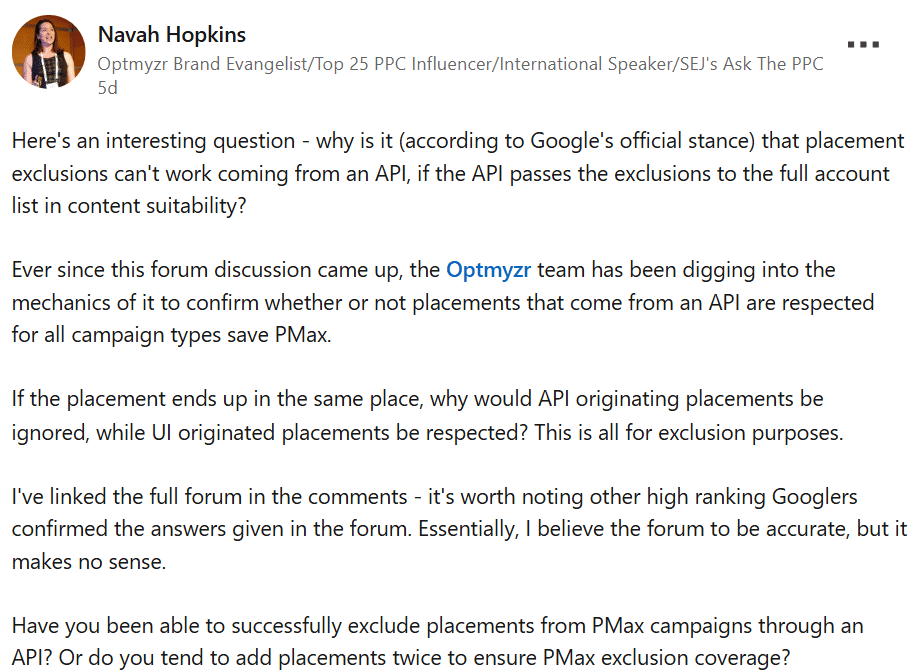Table of Contents


Want to Boost Rankings?
Get a proposal along with expert advice and insights on the right SEO strategy to grow your business!
Get StartedAdvertisers are scratching their heads over Google’s Performance Max (PMax) campaigns due to mixed signals about placement exclusions. Google’s official guidelines say API-based exclusions don’t work for PMax campaigns, but many advertisers report success using them.
This mismatch is creating uncertainty and raising concerns about campaign control and brand safety.
Free SEO Audit: Uncover Hidden SEO Opportunities Before Your Competitors Do
Gain early access to a tailored SEO audit that reveals untapped SEO opportunities and gaps in your website.


Here’s a closer look at what’s happening and how it affects advertisers.
The Placement Exclusion Problem
For Performance Max campaigns, placement exclusions let advertisers prevent ads from showing on undesirable websites. This is essential for maintaining brand reputation and ensuring ads reach the right audience.
The confusion lies here:
- What Google Says: API-based placement exclusions are not supported for PMax campaigns.
- What Advertisers Experience: Many, including automation expert Nils Rooijmans, report that exclusions through APIs work just fine.
- UI-Based Exclusions: Google confirms these work as expected, but this doesn’t help advertisers relying on automation for scale.
This inconsistency has left advertisers wondering which rules to trust, complicating campaign management.
Why This Matters
Take a look at how this confusion impacts advertisers’ ability to safeguard their brands, streamline campaigns, and make the most of automation tools.
- Brand Risk: If exclusions don’t work as intended, ads might appear on questionable sites, damaging a brand’s image.
- Automation Challenges: Many advertisers depend on APIs for managing multiple campaigns efficiently. This uncertainty undermines automation strategies.
- Time and Resources: Without clear answers, advertisers are left testing and troubleshooting, wasting valuable time.
How Did This Start?
Navah Hopkins, Brand Evangelist at Optmyzr, highlighted this issue after spotting a discussion on Google’s help forum.

A Google advisor claimed that API-based placement exclusions don’t work for PMax campaigns.
However, Nils Rooijmans and other advertisers shared successful results contradicting Google’s statement.

This gap between official policy and real-world results raises a key question: Are Google’s guidelines out of date or incomplete?
What’s Next?
Here’s what we can expect and how advertisers can adapt:
Google May Clarify Policies: Given the growing discussion, Google might update its documentation to match real-world functionality.
Advertisers Need to Test: Until Google addresses the issue, advertisers should experiment with API-based and UI-based exclusions to find what works.
Advocacy Will Be Key: Industry voices could push Google to provide clearer answers and better support for advertisers.
Tips for Advertisers
If you’re managing PMax campaigns, here’s how to navigate the confusion:
Monitor Exclusions: Regularly check where your ads appear and verify that exclusions are working.
Document Your Results: Track what methods succeed or fail for your campaigns. This can help you adapt faster.
Stay Connected: Join discussions on LinkedIn or forums to learn from other advertisers’ experiences.
Be Ready to Adjust: Until this issue is resolved, flexibility is your best strategy.
Key Takeaways
- Google’s policy says API-based exclusions don’t work, but advertisers see otherwise.
- The confusion puts brand safety and campaign efficiency at risk.
- Testing is essential to figure out what works for your campaigns.
- Advertisers need clear communication from Google to resolve this issue.
- Stay vigilant and proactive to protect your brand and optimize campaigns.
About the author
Share this article
Find out WHAT stops Google from ranking your website
We’ll have our SEO specialists analyze your website—and tell you what could be slowing down your organic growth.














